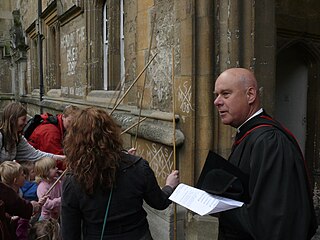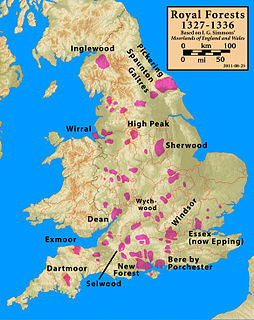Related Research Articles

Magna Carta Libertatum, commonly called Magna Carta, is a royal charter of rights agreed to by King John of England at Runnymede, near Windsor, on 15 June 1215. First drafted by Archbishop of Canterbury, Cardinal Stephen Langton, to make peace between the unpopular king and a group of rebel barons, it promised the protection of church rights, protection for the barons from illegal imprisonment, access to swift justice, and limitations on feudal payments to the Crown, to be implemented through a council of 25 barons. Neither side stood behind their commitments, and the charter was annulled by Pope Innocent III, leading to the First Barons' War.

Purley is an area of the London Borough of Croydon in London, England, 11.7 miles (18.8 km) south of Charing Cross. It had a population of about 14,000 in 2011.

John Horne Tooke, known as John Horne until 1782 when he added the surname of his friend William Tooke to his own, was an English clergyman, politician, and philologist. Associated with radical proponents of parliamentary reform, he stood trial for treason in November 1794.

Oakley is a village and civil parish in Buckinghamshire, England. It has an area of 2,206 acres (893 ha) and includes about 400 households. The 2011 Census recorded the population as 1,007.

A winemaker or vintner is a person engaged in winemaking. They are generally employed by wineries or wine companies, where their work includes:
The Personal Rule was the period from 1629 to 1640, when King Charles I of England, Scotland and Ireland ruled without recourse to Parliament. The King claimed that he was entitled to do this under the Royal Prerogative.

A royal forest, occasionally known as a kingswood, is an area of land with different definitions in England, Wales, Scotland and Ireland. The term forest in the ordinary modern understanding refers to an area of wooded land; however, the original medieval sense was closer to the modern idea of a "preserve" – i.e. land legally set aside for specific purposes such as royal hunting – with less emphasis on its composition. There are also differing and contextual interpretations in Continental Europe derived from the Carolingian and Merovingian legal systems.

Purley Oaks railway station is in the London Borough of Croydon in south London, on the Brighton Main Line 12 miles 34 chains (20.0 km) measured from London Bridge. All trains serving it are operated by Southern and it is in London Travelcard Zone 6. The station has four platforms: a disused side platform on the up fast line, an island platform with a disused face on the down fast line and an eastern face used by up trains, and a side platform on the eastern side used by down trains. The two platforms are only used during engineering works. There is also a pay-and-display car park at the station.

Beating the bounds or perambulating the bounds is an ancient custom still observed in parts of England, Wales, and the New England region of the United States, which traditionally involved swatting local landmarks with branches to maintain a shared mental map of parish boundaries, usually every seven years.

Hainault Forest Country Park is a Country Park located in Greater London, with portions in: Hainault in the London Borough of Redbridge; the London Borough of Havering; and in the Lambourne parish of the Epping Forest District in Essex.

Dibden Purlieu is a village situated on the edge of the New Forest in Hampshire, England. The village merges with the nearby town of Hythe. It is in the civil parish of Hythe and Dibden.

Hale is a small village and civil parish in Hampshire, England. It lies on the border of the New Forest, overlooking the valley of the River Avon. The village is about 3.5 miles (5.6 km) north-east of the town of Fordingbridge, and about 8 miles (13 km) south of the city of Salisbury. Within the parish stands Hale House, a large 18th-century mansion which was the country house of architect Thomas Archer, who also rebuilt Hale church in 1717.

Bedford Purlieus is a 211-hectare (520-acre) ancient woodland in Cambridgeshire, in the United Kingdom. It is a national nature reserve and Site of Special Scientific Interest owned and managed by the Forestry Commission. In Thornhaugh civil parish, 10 km (6.2 mi) south of Stamford and 14 km (8.7 mi) west of Peterborough, the wood is within the Peterborough unitary authority area of Cambridgeshire, and borders Northamptonshire. In Roman times it was an iron smelting centre, during the medieval period it was in the Royal Forest of Rockingham, and later it became part of the estates of the Duke of Bedford. Bedford Purlieus appears to have been continuously wooded at least from Roman times, and probably since the ice receded. The woodland may have the richest range of vascular plants of any English lowland wood. It acquired particular significance in the 1970s as an early subject for the historical approach to ecology and woodland management.

The Forest of Dartmoor is an ancient royal forest covering part of Dartmoor, Devon, England.
The Western Rising was a series of riots which took place during 1626–1632 in Gillingham Forest on the Wiltshire-Dorset border, Braydon Forest in Wiltshire, and the Forest of Dean, Gloucestershire in response to disafforestation of royal forests, sale of royal lands and enclosure of property by the new owners. Disafforestation is a change in legal status that allows the land to be sold normally, rather than being preserved as a forest. Enclosure takes the land out of common use, denying access to non-owners who had previously used it.

Denny Lodge is a large civil parish in the New Forest in Hampshire, England. It covers a large area of heathland and woodland encompassing much of the eastern side of the New Forest, but contains no towns, villages, churches, or schools.

The Forests of Mara and Mondrem were adjacent medieval forests in Cheshire, England, which in the 11th century extended to over 60 square miles (160 km2), stretching from the Mersey in the north almost to Nantwich in the south, and from the Gowy in the west to the Weaver in the east. Mara and Mondrem were a hunting forest of the Norman Earls of Chester, established soon after 1071 by the first earl, Hugh d'Avranches. They might earlier have been an Anglo-Saxon hunting forest. Game included wild boar, and red, fallow and roe deer.

Feckenham Forest was a royal forest, centred on the village of Feckenham, covering large parts of Worcestershire and west Warwickshire. It was not entirely wooded, nor entirely the property of the King. Rather, the King had legal rights over game, wood and grazing within the forest, and special courts imposed harsh penalties when these rights were violated. Courts and the forest gaol were located at Feckenham and executions took place at Gallows Green near Hanbury.
Kinver Forest was a Royal Forest, mainly in Staffordshire.

The Forest of Knaresborough was a royal hunting forest in Yorkshire, England. It covered an area of some 45 square miles (120 km2) west and south of the town of Knaresborough, between the River Nidd and the River Wharfe, then in the West Riding of Yorkshire and now in North Yorkshire.
References
- This article incorporates text from a publication now in the public domain : Chisholm, Hugh, ed. (1911). "Purlieu". Encyclopædia Britannica . Vol. 22 (11th ed.). Cambridge University Press. p. 665.